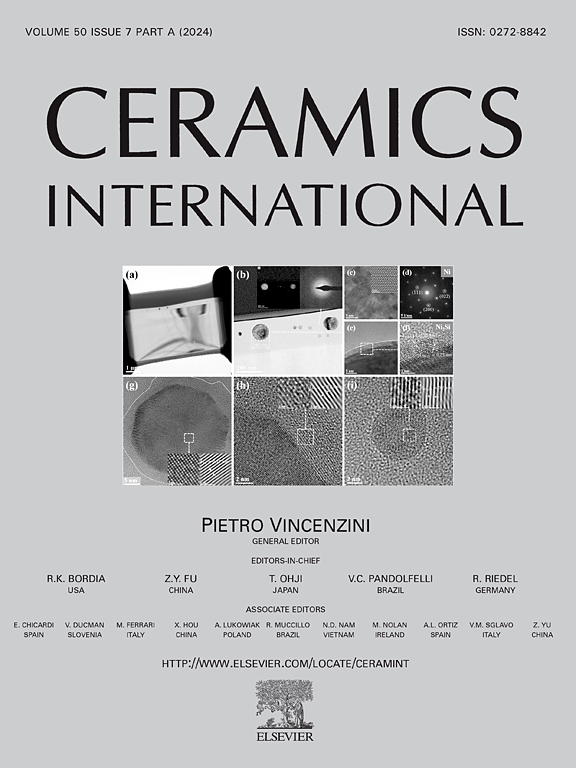掺y2o3锆酸镧tbc在Na2SO4+V2O5环境中的热腐蚀行为
IF 5.6
2区 材料科学
Q1 MATERIALS SCIENCE, CERAMICS
引用次数: 0
摘要
近年来,锆酸镧(LZ)热障涂层热腐蚀性能的提高引起了人们的广泛关注。本研究评价了在La2Zr2O7结构中加入Y2O3的(La0.6Y0.4)2Zr2O7 (LYZ)涂层的热腐蚀行为。为此,采用LZ和LYZ涂层作为单层面涂层。YSZ/LZ和YSZ/LYZ涂层采用YSZ夹层作为双层面漆。然后使用大气等离子喷涂(APS)将这些面涂层与NiCrAlY结合涂层一起应用于IN738LC基板。采用维氏压痕法测定了LZ和LYZ的断裂韧性。在LYZ涂层中观察到,在LZ中引入Y2O3导致断裂韧性从0.81 mpam0.5增加到1.28 MPa0.5。在循环模式下研究了样品的耐热腐蚀性能。在每个循环中,样品在900℃下暴露于Na2SO4+V2O5盐的混合物中4小时。相对于LZ涂层,LYZ涂层在腐蚀环境中表现出更好的性能。与LZ涂层相比,LYZ涂层具有更高的热膨胀系数,其热应力降低。这种减少促成了热腐蚀机制从热机械到热化学的转变。此外,LaVO4被确定为两种涂层的主要腐蚀产物。然而,在LYZ涂层中,少量的Y2O3溶解在LaVO4中,导致形貌从长方体变为棒状。本文章由计算机程序翻译,如有差异,请以英文原文为准。
Hot corrosion behavior of Y2O3-doped lanthanum zirconate TBCs in Na2SO4+V2O5 environment
The improvement of hot corrosion performance of lanthanum zirconate (LZ) thermal barrier coatings (TBCs) has attracted significant interest in recent years. The hot corrosion behavior of a (La0.6Y0.4)2Zr2O7 (LYZ) coating, resulting from the addition of Y2O3 to the La2Zr2O7 structure, was evaluated in the current study. For this purpose, LZ and LYZ coatings were used as single-layer top coats. YSZ/LZ and YSZ/LYZ coatings, featuring a YSZ interlayer, were used as double-layer top coats. These top coats, along with a NiCrAlY bond coat, were then applied to the IN738LC substrate using atmospheric plasma spraying (APS). The fracture toughness of both LZ and LYZ was measured by Vickers indentation. The introduction of Y2O3 into the LZ resulted in an increase in fracture toughness from 0.81 MPam0.5–1.28 MPa0.5, as observed in the LYZ coating. The hot corrosion resistance of the samples was investigated in a cyclic mode. In each cycle, samples were exposed to a mixture of Na2SO4+V2O5 salts at 900 °C for 4 h. LYZ coating showed better performance in corrosive environments relative to the LZ coating. The LYZ coating, with its higher thermal expansion coefficient compared to the LZ coating, experienced reduced thermal stresses. This reduction contributed to a shift in the hot corrosion mechanism from thermomechanical to thermochemical. Furthermore, LaVO4 was identified as the primary corrosion product for both coatings. However, in the LYZ coating, a small amount of Y2O3 dissolved within the LaVO4, leading to a morphological change from cuboid to rod-shaped.
求助全文
通过发布文献求助,成功后即可免费获取论文全文。
去求助
来源期刊

Ceramics International
工程技术-材料科学:硅酸盐
CiteScore
9.40
自引率
15.40%
发文量
4558
审稿时长
25 days
期刊介绍:
Ceramics International covers the science of advanced ceramic materials. The journal encourages contributions that demonstrate how an understanding of the basic chemical and physical phenomena may direct materials design and stimulate ideas for new or improved processing techniques, in order to obtain materials with desired structural features and properties.
Ceramics International covers oxide and non-oxide ceramics, functional glasses, glass ceramics, amorphous inorganic non-metallic materials (and their combinations with metal and organic materials), in the form of particulates, dense or porous bodies, thin/thick films and laminated, graded and composite structures. Process related topics such as ceramic-ceramic joints or joining ceramics with dissimilar materials, as well as surface finishing and conditioning are also covered. Besides traditional processing techniques, manufacturing routes of interest include innovative procedures benefiting from externally applied stresses, electromagnetic fields and energetic beams, as well as top-down and self-assembly nanotechnology approaches. In addition, the journal welcomes submissions on bio-inspired and bio-enabled materials designs, experimentally validated multi scale modelling and simulation for materials design, and the use of the most advanced chemical and physical characterization techniques of structure, properties and behaviour.
Technologically relevant low-dimensional systems are a particular focus of Ceramics International. These include 0, 1 and 2-D nanomaterials (also covering CNTs, graphene and related materials, and diamond-like carbons), their nanocomposites, as well as nano-hybrids and hierarchical multifunctional nanostructures that might integrate molecular, biological and electronic components.
 求助内容:
求助内容: 应助结果提醒方式:
应助结果提醒方式:


